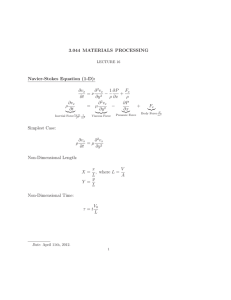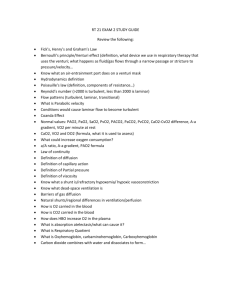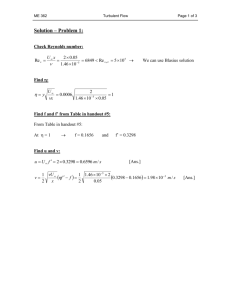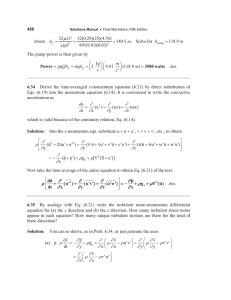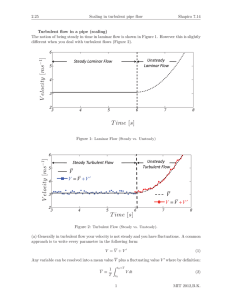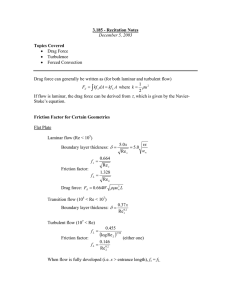Document 13608865
advertisement
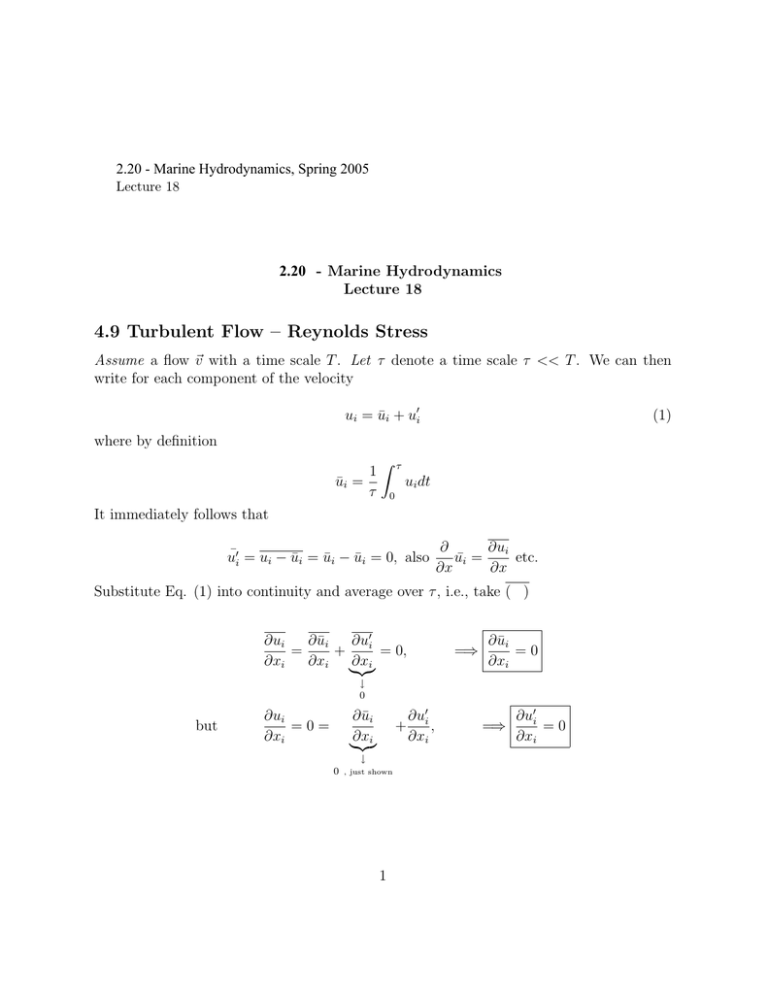
2.20 - Marine Hydrodynamics, Spring 2005 Lecture 18 2.20 - Marine Hydrodynamics Lecture 18 4.9 Turbulent Flow – Reynolds Stress Assume a flow v with a time scale T . Let τ denote a time scale τ << T . We can then write for each component of the velocity ui = ūi + ui (1) where by definition 1 ūi = τ 0 τ ui dt It immediately follows that ∂ ∂ui u¯i = ui − ūi = ūi − ūi = 0, also ūi = etc. ∂x ∂x Substitute Eq. (1) into continuity and average over τ , i.e., take ( ) ∂ūi ∂ui ∂ui = + = 0, ∂xi ∂xi ∂xi =⇒ ∂ūi =0 ∂xi ↓ 0 but ∂ui = 0 = ∂xi ∂u + i , ∂xi ∂ūi ∂x i 0 ↓ , just shown 1 =⇒ ∂ui =0 ∂xi Substitute Eq. (1) into the momentum equations and take ( ) ∂ui ∂ui 1 ∂τij 1 ∂p + uj = =− + ν∇2 ui ρ ∂xi ∂t ∂xj ρ ∂xj ∂ui ⎧ 2 ⎨ ν∇2 ui = ν∇ ui ∂ui ∂ūi = + ; similarly ⎩ ∂t ∂t ∂t 0 uj ∂p ∂xi = ∂ (p̄ ∂xi + p ) = ∂p̄ ∂xi etc. ∂ ∂ui ∂ ūi ∂ūi ∂u ∂ = u ¯j + uj (¯ ui + ui ) = ūj + uj + ūj i +uj u ∂xj ∂xj ∂xj ∂xj ∂xj ∂xj i 0 0 but from continuity we have uj ∂ ∂ u i = u u − ui ∂xj ∂xj j i ∂uj ∂xj 0→by continuity and thus we finally obtain ∂ūi 1 ∂p ∂ ∂ūi + ūj =− + ν∇2 ūi − uu ∂t ∂xj ρ ∂xi ∂xj i j 1 ∂ τ ρ ∂xj ij Reynolds averaged N-S equation: ∂ūi ∂ūi 1 ∂ + ūj = τij − ρui uj ∂t ∂xj ρ ∂xj Reynolds stress: τRij ≡ −ρui uj 2 4.10 Turbulent Boundary Layer Over a Smooth Flat Plate We have already seen that the function of the friction coefficient Cf (ReL ) differs for laminar and turbulent flows. In this paragraph we will discuss the case of a turbulent boundary layer. Following a procedure similar to that for flow past a body of general geometry, we will use an approximate velocity profile, obtain the P-Flow solution and eventually substitute everything into von Karman’s momentum integral equation. The velocity profiles used in practice are either empirical ((1/7)th power) or semi-empirical (logarithmic) laws. log y u Uo δ U Uo o 1/7 u log y δ 4.10.1 (1/7)th Power Velocity Profile Law Let the velocity profile be determined by the following empirical law y 1/7 ū = Uo δ (2) where δ = δ(x) is to be determined. From equation (2) we can obtain directly δ ∗ and θ δ 8 7 ∼ θ = δ = 0.0972 δ 72 δ∗ = However, we need to use an additional empirical law to determine the skin friction. From Blasius’ law of friction for pipes we obtain an expression for τo −1/4 τo Uo δ = 0.0227 ν ρUo2 3 From P-Flow for flow past a flat plate we have U (x) = U0 = const, and dp/dx = 0 Substituting δ ∗ , θ, τo , Uo into von Karman’s moment equation τo d = (θ) =⇒ 0.0227 2 dx ρUo Uo δ ν −1/4 = 7 dδ 72 dx This is a 1s t order ODE for δ. One BC is required. We assume that the the flow is tripped at x = 0, i.e., at x = 0 the flow is already turbulent. Further on, we assume that the turbulent boundary layer starts at x = 0, i.e., δ(0) = 0. It follows that δ (x) ∼ = 0.373x Uo x ν −1/5 =⇒ δ ∼ = 0.373Re−1/5 x x Compare: Laminar Boundary Layer Turbulent Boundary Layer (1/7th power law) √ δ (x) ∝ x4/5 δ (x) ∝ x 4 1/5 νx νx ∗ ∼ 0.047 1.72 δ∗ ∼ δ = = Uo Uo Once the profile has been determined we can evaluate the friction drag D = 0.036 ρUo2 BL Re−1/5 L Thus, the friction coefficient for turbulent (tripped and/or ReL > 5 × 105 ) flow over a flat plate is D = 0.073Re−1/5 Cf = L 1 ρU 2 BL 2 o 4.10.2 Logarithmic Velocity Profile Law If the velocity profile is determined by the semi-empirical logarithmic velocity pro­ file law, following an approach similar to that for the 1/7th power law, we obtain Schoenherr’s formula for the friction coefficient 0.242 = log10 (ReL Cf ) Cf 4 4.10.3 Summary of Boundary Layer Over a Flat Plate Turbulent BL (1/7th power law) Laminar BL (Blasius) δ ∝ Re−1/2 x x δ ∗ = 1.72xRe−1/2 ∝ x δ ∝ Re−1/5 x x √ δ ∗ = 0.047xRe−1/5 ∝ x4/5 x x τo = 0.0227ρUo2 Re−1/4 δ τo = 0.332ρUo2 Re−1/2 x τo = 0.02297ρUo2 Re−1/5 x D = 0.664ρU02 (BL)Re−1/2 L D = 0.03625ρU02 (BL)Re−1/5 L Cf ≡ D ρUo2 (BL) = 1.328Re−1/2 L Cf ≡ D ρUo2 (BL) = 0.0725Re−1/5 L For τo , the cross-over is at Rex ∼ 3.4 x 103 , i.e., Cf (τo )laminar > (τo )turbulent for Rex < 3.4 × 103 (τo )laminar ∼ (τo )turbulent for Rex ∼ 3.4 × 103 (τo )laminar < (τo )turbulent for Rex > 3.4 × 103 C f L ~ RL− 1 2 C fT ~ RL− 1 5 ~ 0.01 Therefore, for most prototype scales: ln (RL) (Cf )turbulent > (Cf )laminar (τo )turbulent > (τo )laminar RL ~ 1.6 x 104 5
